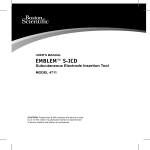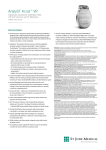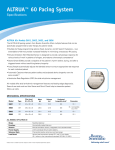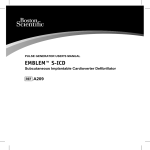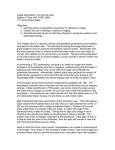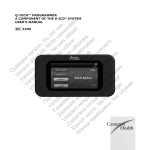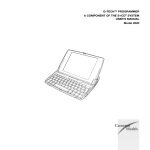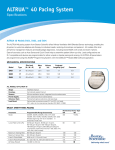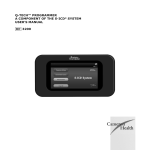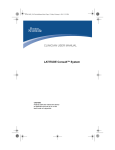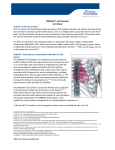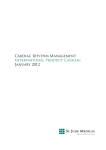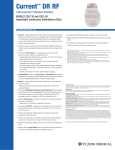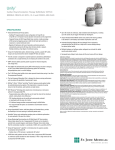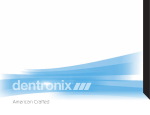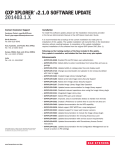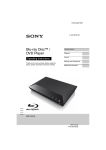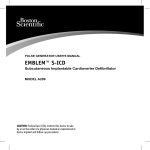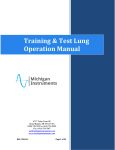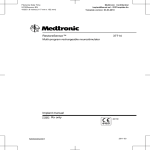Download EMBLEM™ S-ICD - Boston Scientific
Transcript
USER'S MANUAL EMBLEM™ S-ICD Subcutaneous Electrode MODEL 3401 CAUTION: Federal law (USA) restricts this device to sale by or on the order of a physician trained or experienced in device implant and follow-up procedures. EMBLEM is a trademark of Boston Scientific. This product may be protected by one or more patents. Patent information can be obtained at http://www.bostonscientific.com/patents. Table of Contents Description1 Related Information 1 Intended Audience 1 Indications for Use 2 Contraindications2 Warnings2 General2 Handling3 Implantation3 Post-Implant3 Precautions3 Clinical Considerations 3 Sterilization and Storage 3 Implantation4 Hospital and Medical Environments 4 Explant and Disposal 5 Potential Adverse Events 6 Using the EMBLEM S-ICD Subcutaneous Electrode 7 Items Included in Package 7 Implanting the EMBLEM S-ICD System 8 Creating the Device Pocket 9 Implanting the EMBLEM S-ICD Subcutaneous Electrode 9 Post Implant Follow-Up Procedures 12 Explantation13 EMBLEM S-ICD Subcutaneous Electrode Diagram 14 EMBLEM S-ICD Subcutaneous Electrode Specifications 15 Definition of Package Label Symbols 16 Warranty Information 16 Description The EMBLEM™ S-ICD subcutaneous electrode is a component of the Boston Scientific S-ICD System, which is prescribed for patients when cardiac arrhythmia management is warranted. The S-ICD System detects cardiac activity and provides defibrillation therapy. The subcutaneous electrode is implanted with the distal portion positioned parallel to the left sternal border and the proximal end connected to an EMBLEM S-ICD System pulse generator via an SQ-1 S-ICD connector.1 The EMBLEM subcutaneous electrode is also compatible with the Cameron Health Model 1010 SQ-RX pulse generator. The subcutaneous electrode includes one high voltage shock electrode coil for the purpose of providing defibrillation energy. The shock electrode is constructed using multifilars of metallic wire formed into a defibrillation coil 8 cm in length. Defibrillation is delivered between the coil on the subcutaneous electrode and the electrically conductive pulse generator case. The subcutaneous electrode also includes proximal and distal sensing ring electrodes. These sense electrodes are constructed using metallic tubing mechanically affixed to the body of the subcutaneous electrode. Sensing occurs between the two electrically conductive rings on the subcutaneous electrode or between either of the rings on the subcutaneous electrode and the electrically conductive pulse generator case. Related Information For additional information about other components of the S-ICD System, refer to the following: • EMBLEM S-ICD Pulse Generator User’s Manual • EMBLEM S-ICD Subcutaneous Electrode Insertion Tool User’s Manual • EMBLEM S-ICD Programmer User’s Manual A summary of the S-ICD System Clinical Investigation, including observed adverse events, can be obtained by contacting Boston Scientific using the information on the back cover. Intended Audience This literature is intended for use by professionals trained or experienced in device implant and/or follow-up procedures. 1 SQ-1 is a non-standard connector unique to the S-ICD System. 1 Indications for Use The S-ICD System is intended to provide defibrillation therapy for the treatment of life-threatening ventricular tachyarrhythmias in patients who do not have symptomatic bradycardia, incessant ventricular tachycardia, or spontaneous, frequently recurring ventricular tachycardia that is reliably terminated with anti-tachycardia pacing. Contraindications Unipolar pacing and impedance-based features are contraindicated for use with the S-ICD System. Warnings Note: Before using the S-ICD System, read and follow all warnings and precautions provided in the EMBLEM S-ICD Pulse Generator User’s Manual. General • Labeling knowledge. Read this manual thoroughly before using the S-ICD System to avoid damage to the pulse generator and/or subcutaneous electrode. Such damage can result in patient injury or death. • For single patient use only. Do not reuse, reprocess, or resterilize. Reuse, reprocessing, or resterilization may compromise the structural integrity of the device and/or lead to device failure which, in turn, may result in patient injury, illness, or death. Reuse, reprocessing, or resterilization may also create a risk of contamination of the device and/or cause patient infection or cross-infection, including, but not limited to, the transmission of infectious disease(s) from one patient to another. Contamination of the device may lead to injury, illness, or death of the patient. • Component Compatibility. All Boston Scientific S-ICD implantable components are designed for use with the Boston Scientific or Cameron Health S-ICD System only. Connection of any S-ICD System components to a non-compatible component will result in failure to deliver life-saving defibrillation therapy. • Backup defibrillation protection. Always have external defibrillation equipment and medical personnel skilled in CPR available during implant and follow-up testing. If not terminated in a timely fashion, an induced ventricular tachyarrhythmia can result in the patient’s death. 2 Handling • Proper Handling. Handle the components of the S-ICD System with care at all times and maintain proper sterile technique. Failure to do so may lead to injury, illness, or death of the patient. • Do not damage components. Do not modify, cut, kink, crush, stretch or otherwise damage any component of the S-ICD System. Impairment to the S-ICD System may result in an inappropriate shock or failure to deliver therapy to the patient. • Handling the subcutaneous electrode. Use caution handling the subcutaneous electrode connector. Do not directly contact the connector with any surgical instruments such as forceps, hemostats, or clamps. This could damage the connector. A damaged connector may result in compromised sealing integrity, possibly leading to compromised sensing, loss of therapy, or inappropriate therapy. Implantation • System dislodgement. Use appropriate anchoring techniques as described in the implant procedure to prevent S-ICD System dislodgement and/or migration. Dislodgement and/or migration of the S-ICD System may result in an inappropriate shock or failure to deliver therapy to the patient. Post-Implant • Magnetic Resonance Imaging (MRI) exposure. Do not expose a patient to MRI scanning. Strong magnetic fields may damage the pulse generator and/or subcutaneous electrode, possibly resulting in injury to or death of the patient. • Diathermy. Do not expose a patient with an implanted S-ICD System to diathermy. The interaction of diathermy therapy with an implanted S-ICD pulse generator or electrode can damage the pulse generator and cause patient injury. Precautions Clinical Considerations • Pediatric Use. The S-ICD System has not been evaluated for pediatric use. • Available Therapies. The S-ICD System does not provide long-term bradycardia pacing, cardiac resynchronization therapy (CRT) or anti-tachycardia pacing (ATP). Sterilization and Storage • If package is damaged. The blister trays and contents are sterilized with ethylene oxide gas before final packaging. When the pulse generator and/or subcutaneous electrode is received, it is sterile provided the container is intact. If the packaging is wet, punctured, opened, or otherwise damaged, return the pulse generator and/or subcutaneous electrode to Boston Scientific. 3 • • Use by date. Implant the pulse generator and/or subcutaneous electrode before or on the USE BY date on the package label because this date reflects a validated shelf life. For example, if the date is January 1, do not implant on or after January 2. Storage temperature. The recommended storage temperature range is -18°C to +55°C (0°F to 131°F). Implantation • Creating the subcutaneous tunnel. Use only the electrode insertion tool to create the subcutaneous tunnel when implanting and positioning the subcutaneous electrode. Avoid tunneling close to any other subcutaneously implanted medical devices or components, for example an implantable insulin pump, drug pump, or ventricular assist device. • Suture location. Suture only those areas indicated in the implant instructions. • Do not suture directly over subcutaneous electrode body. Do not suture directly over the subcutaneous electrode body, as this may cause structural damage. Use the suture sleeve to prevent subcutaneous electrode movement. • Do not bend the subcutaneous electrode near the electrode-header interface. Insert the subcutaneous electrode connector pin straight into the pulse generator header port. Do not bend the subcutaneous electrode near the subcutaneous electrode-header interface. Improper insertion can cause insulation or connector damage. • Sternal wires. When implanting the S-ICD system in a patient with sternal wires, ensure that there is no contact between the sternal wires and the distal and proximal sense electrodes (for example, by using fluoroscopy). Compromised sensing can occur if metalto-metal contact occurs between a sense electrode and a sternal wire. If necessary, re-tunnel the electrode to ensure sufficient separation between the sense electrodes and the sternal wires. Hospital and Medical Environments • External defibrillation. External defibrillation or cardioversion can damage the pulse generator or subcutaneous electrode. To help prevent damage to implanted system components, consider the following: • Avoid placing a pad (or paddle) directly over the pulse generator or subcutaneous electrode. Position the pads (or paddles) as far from the implanted system components as possible. • Set energy output of external defibrillation equipment as low as clinically acceptable. • Following external cardioversion or defibrillation, verify pulse generator function (see the appropriate S-ICD pulse generator manual for suggested post-therapy follow-up actions). 4 • • Cardiopulmonary resuscitation. Cardiopulmonary resuscitation (CPR) may temporarily interfere with sensing and may cause delay of therapy. Electrocautery and Radio Frequency (RF) Ablation. Electrocautery and RF ablation may induce ventricular arrhythmias and/or fibrillation, and may cause inappropriate shocks and inhibition of post-shock pacing. Additionally, exercise caution when performing any other type of cardiac ablation procedure in patients with implanted devices. If electrocautery or RF ablation is medically necessary, observe the following to minimize risk to the patient and device: • Program the pulse generator to Therapy Off mode. • Have external defibrillation equipment available. • Avoid direct contact between the electrocautery equipment or ablation catheters and the pulse generator and subcutaneous electrode. • Keep the path of the electrical current as far away as possible from the pulse generator and subcutaneous electrode. • If RF ablation and/or electrocautery is performed on tissue near the device or subcutaneous electrode, verify pulse generator function (see the appropriate SICD pulse generator manual for suggested post-therapy follow-up actions). • For electrocautery, use a bipolar electrocautery system where possible and use short, intermittent, and irregular bursts at the lowest feasible energy levels. When the procedure is finished, return the pulse generator to Therapy On mode. Explant and Disposal • Handling at explant. Clean and disinfect implanted components using standard biohazard handling techniques. 5 Potential Adverse Events Potential adverse events related to implantation of the S-ICD System may include, but are not limited to, the following: • Acceleration/induction of atrial or ventricular arrhythmia • Adverse reaction to induction testing • Allergic/adverse reaction to system or medication • Bleeding • Conductor fracture • Cyst formation • Death • Delayed therapy delivery • Discomfort or prolonged healing of incision • Electrode deformation and/or breakage • Electrode insulation failure • Erosion/extrusion • Failure to deliver therapy • Fever • Hematoma/seroma • Hemothorax • Improper electrode connection to the device • Inability to communicate with the device • Inability to defibrillate or pace • Inappropriate post-shock pacing • Inappropriate shock delivery • Infection • Keloid formation • Migration or dislodgement • Muscle/nerve stimulation • Nerve damage • Pneumothorax • Post-shock/post-pace discomfort • Premature battery depletion • Random component failures • Stroke • Subcutaneous emphysema • Surgical revision or replacement of the system • Syncope • Tissue redness, irritation, numbness or necrosis If any adverse events occur, invasive corrective action and/or S-ICD System modification or removal may be required. 6 Patients who receive an S-ICD System may develop psychological disorders that may include, but are not limited to, the following: • Depression/anxiety • Fear of device malfunction • Fear of shocks • Phantom shocks Using the EMBLEM S-ICD Subcutaneous Electrode Items Included in Package The subcutaneous electrode has been sterilized with ethylene oxide gas and is packaged in a sterile container that is suitable for use in the operating field. Store in a clean, dry area. Each package contains the following: • One EMBLEM S-ICD subcutaneous electrode, Model 3401 • Two silicone suture sleeves • One EMBLEM S-ICD Subcutaneous Electrode User’s Manual 7 Implanting the EMBLEM S-ICD System This section presents the information necessary for implanting the EMBLEM S-ICD subcutaneous electrode using the EMBLEM S-ICD subcutaneous electrode insertion tool (the “EIT”). The EMBLEM S-ICD subcutaneous electrode can also be implanted using the Cameron Health Model 4010 Q-GUIDE EIT. Warning: All Boston Scientific S-ICD implantable components are designed for use with the Boston Scientific or Cameron Health S-ICD System only. Connection of any S-ICD System components to a non-compatible component will result in failure to deliver life-saving defibrillation therapy. The S-ICD System is designed to be positioned using anatomical landmarks. However, it is recommended to review a pre-implant chest x-ray in order to confirm that a patient does not have notably atypical anatomy (e.g., dextrocardia). Additionally, it is not recommended to deviate from the implant instructions to accommodate for physical body size or habitus, unless a pre-implant chest x-ray has been reviewed. The device and subcutaneous electrode are typically implanted subcutaneously in the left thoracic region (Figure 1). The EIT is used to create the subcutaneous tunnels in which the electrode is inserted. Figure 1: Placement of the S-ICD System 8 Creating the Device Pocket The device is implanted in the left lateral thoracic region. To create the device pocket, make an incision such that the device can be placed in the vicinity of the left 5th and 6th intercostal spaces and near the mid-axillary line (Figure 2). This can be accomplished by making an incision along the inframammary crease. Figure 2: Creating the device pocket Implanting the EMBLEM S-ICD Subcutaneous Electrode The procedure described below is one of several surgical approaches that can be used to appropriately implant and position the electrode. Regardless of the surgical approach, the defibrillation coil must be positioned parallel to the sternum, in close proximity to, or in contact with the deep fascia, approximately 2 cm from the sternal midline (Figure 1). In addition, good tissue contact with the electrode and pulse generator is important to optimize sensing and therapy delivery. Use standard surgical techniques to obtain good tissue contact. For example, keep the tissue moist and flushed with sterile saline, express any residual air out through the incisions prior to closing and, when closing the skin, take care not to introduce air into the subcutaneous tissue. 1. 2. Make a small, 2 cm horizontal incision at the xiphoid process (xiphoid incision). Note: If desired, in order to facilitate attachment of the suture sleeve to the fascia following electrode placement, two suture ties to the fascia can be made at the xiphoid incision prior to continuing. Insert the distal tip of the EIT at the xiphoid incision and tunnel laterally until the distal tip emerges at the device pocket. Note: The EIT is malleable and can be curved to match the patient’s anatomical profile. Caution: Use only the electrode insertion tool to create the subcutaneous tunnel when implanting and positioning the subcutaneous electrode. Avoid tunneling close to any other subcutaneously implanted medical devices or components, for example an implantable insulin pump, drug pump, or ventricular assist device. 9 3. Using conventional suture material, tie the anchoring hole of the subcutaneous electrode to the EIT creating a long 15-16 cm loop (Figure 3). Figure 3: Connecting the distal end of the subcutaneous electrode to the EIT 4. 5. 6. 10 With the subcutaneous electrode attached, carefully pull the EIT back through the tunnel to the xiphoid incision until the proximal sensing electrode emerges. Place a suture sleeve over the subcutaneous electrode shaft 1 cm below the proximal sensing electrode. Using the preformed grooves, bind the suture sleeve to the subcutaneous electrode shaft using 2-0 silk or similar non-absorbable suture material, making sure not to cover the proximal sensing electrode. Check the suture sleeve after anchoring to assure stability by grasping the suture sleeve with fingers and try to move the subcutaneous electrode in either direction. Note: Do not secure the suture sleeve and subcutaneous electrode to the fascia until electrode placement is complete. Make a second incision approximately 14 cm superior to the xiphoid incision (superior incision). If desired, place the exposed subcutaneous electrode on the skin to make this measurement. The distance between the superior and xiphoid incisions must accommodate the portion of the subcutaneous electrode from the distal sensing electrode to the proximal sensing electrode. Pre-place one or two fascial sutures in superior incision. Use a non-absorbable suture material of appropriate size for long term retention. Apply gentle traction to ensure adequate tissue fixation. Retain the needle on the suture for later use in passing through the electrode anchoring hole. 7. Insert the distal tip of the EIT into the xiphoid incision and tunnel subcutaneously towards the superior incision, staying as close to the deep fascia as possible (Figure 4). Figure 4: Tunneling to superior incision 8. Once the distal tip of the EIT emerges from the superior incision, disconnect and retain the suture loop from the distal tip of the EIT. Secure the ends of the suture with a surgical clamp. Remove the EIT. 9. Using the secured suture at the superior incision, carefully pull the suture and subcutaneous electrode through the tunnel until the anchoring hole emerges. The subcutaneous electrode should be parallel to the sternal midline with the defibrillation coil in close proximity to the deep fascia. 10. Cut and discard the suture material. 11. At the xiphoid incision, secure the suture sleeve with the subcutaneous electrode to the fascia using 2-0 silk or similar non-absorbable suture material. Warning: Use appropriate anchoring techniques as described in the implant procedure to prevent S-ICD System dislodgement and/or migration. Dislodgement and/or migration of the S-ICD System may result in an inappropriate shock or failure to deliver therapy to the patient. Caution: Do not suture directly over the subcutaneous electrode body, as this may cause structural damage. Use the suture sleeve to prevent subcutaneous electrode movement. Caution: Suture only those areas indicated in the implant instructions. Note: Ensure that the suture is securely fastened to fascia by gently tugging on the suture prior to tying to the suture sleeve and subcutaneous electrode. 11 12. At the superior incision, secure the anchoring hole to the fascia using the pre-placed sutures from step 6 (Figure 5). Figure 5: Anchoring the distal electrode tip of the subcutaneous electrode Note: Ensure that the suture is securely fastened to fascia by gently tugging on the suture prior to tying to the subcutaneous electrode anchoring hole. 13. Gently tug the subcutaneous electrode at the superior incision to ensure the anchoring hole is secured to the fascia. 14. To dispose of the EIT, return the used product to the original package, then dispose in a biohazard container. 15. To ensure good tissue contact with the implanted subcutaneous electrode, flush the xiphoid and superior incisions with sterile saline solution and apply firm pressure along the electrode to express any residual air out through the incisions prior to closing. For information on connecting the subcutaneous electrode to the pulse generator, as well as information about setup of the pulse generator and defibrillation testing, refer to the appropriate S-ICD pulse generator user’s manual. (Either the Boston Scientific EMBLEM S-ICD Pulse Generator User’s Manual or the Cameron Health SQ-RX Model 1010 Pulse Generator User’s Manual, depending on which S-ICD pulse generator is being used.) Additional information on post implant follow-up and explant of the system can also be found in the S-ICD pulse generator manual. Post Implant Follow-Up Procedures It is recommended that device functions be evaluated with periodic follow-up testing by trained personnel to enable review of device performance and associated patient health status throughout the life of the device. Refer to the appropriate pulse generator literature for more information. 12 During a follow-up procedure, it is recommended that the location of the subcutaneous electrode be periodically verified by palpation and/or X-ray. When device communication with the programmer is established, the programmer automatically notifies the physician of any unusual conditions. Refer to the EMBLEM S-ICD Programmer User’s Manual for more information. Warning: Always have external defibrillation equipment and medical personnel skilled in CPR available during implant and follow-up testing. If not terminated in a timely fashion, an induced ventricular tachyarrhythmia can result in the patient’s death. Patient management and follow-up are at the discretion of the patient’s physician, but are recommended one month after implant and at least every 3 months to monitor the condition of the patient and evaluate device function. Explantation Note: Return all explanted pulse generators and subcutaneous electrodes to Boston Scientific. Examination of explanted pulse generators and subcutaneous electrodes can provide information for continued improvement in system reliability and warranty considerations. Warning: Do not reuse, reprocess, or resterilize. Reuse, reprocessing, or resterilization may compromise the structural integrity of the device and/or lead to device failure which, in turn, may result in patient injury, illness, or death. Reuse, reprocessing, or resterilization may also create a risk of contamination of the device and/or cause patient infection or cross-infection, including, but not limited to, the transmission of infectious disease(s) from one patient to another. Contamination of the device may lead to injury, illness, or death of the patient. Caution: Clean and disinfect implanted components using standard biohazard handling techniques. Contact Boston Scientific when any of the following occur: • When a product is removed from service. • In the event of patient death (regardless of cause), along with an autopsy report, if performed. • For other observation or complications. Note: Disposal of explanted pulse generators and/or subcutaneous electrodes is subject to applicable laws and regulations. For a Returned Product Kit, contact Boston Scientific using the information on the back cover. Consider the following items when explanting and returning the pulse generator and/or subcutaneous electrode: • Interrogate the pulse generator and print all reports. • Deactivate the pulse generator before explantation. • Disconnect the subcutaneous electrode from the pulse generator. 13 • If subcutaneous electrode is explanted, attempt to remove it intact, and return it regardless of condition. Do not remove the subcutaneous electrode with hemostats or any other clamping tool that may damage it. Resort to tools only if manual manipulation cannot free the subcutaneous electrode. Wash, but do not submerge, the pulse generator and subcutaneous electrode to remove body fluids and debris using a disinfectant solution. Do not allow fluids to enter the pulse generator’s connector port. Use a Boston Scientific Returned Product Kit to properly package the pulse generator and/or subcutaneous electrode, and send it to Boston Scientific. • • EMBLEM S-ICD Subcutaneous Electrode Diagram 1 3 6 2 8 8 cm 4 5 7 45 cm [1] Anchoring Hole [2] Distal Sensing Electrode [3] Defibrillation Coil [4] Proximal Sensing Electrode [5] Terminal electrode connection for proximal sensing electrode [6] SQ-1 S-ICD connector (non-standard) [7] Terminal electrode connection for defibrillation coil [8] Terminal Pin (electrode connection for distal sensing electrode) Figure 6: EMBLEM S-ICD Model 3401 Subcutaneous Electrode Dimensions 14 EMBLEM S-ICD Subcutaneous Electrode Specifications Table 1: Electrode Specifications Component Specification Connector SQ-1 S-ICD connector (non-standard) Length 45 cm Distal Tip Size 12 Fr Coil Size 9 Fr Electrode Shaft Size 7 Fr Distal Sensing Surface Area 36 mm2 Proximal Sensing Surface Area 46 mm2 Sensing Location Distal electrode at tip Proximal electrode 120 mm from tip Defibrillation Surface Area 750 mm2 Defibrillation Location 20 mm from tip Insulation Material Polyurethane Electrode Material, Sensing Conductors and Connector Pins MP35N Suture Sleeve Material Silicone Storage Temperature Range -18°C to +55°C (0°F to 131°F) Maximum outer diameter 4.0 mm Defibrillation coil diameter 3.0 mm Lead shock impedance 25-200 Ωa Maximum Lead Conductor Resistance a From high voltage terminal ring connection to defibrillation coil 1Ω From low voltage terminal pin to distal sensing electrode ring 50 Ω From low voltage distal terminal sensing electrode connection to proximal sensing electrode ring 50 Ω post-shock pacing uses the same vector as shocking 15 Definition of Package Label Symbols Table 2: Packaging Symbols Symbol Description Symbol Description Sterilized using ethylene oxide Date of manufacture Authorized Representative in the European Community Use by Serial number Temperature limitation Do not reuse Consult instructions for use Reference number Open here Do not resterilize Manufacturer Lot number SQ-1 SQ-1 S-ICD connector (nonstandard) Do not use if package is damaged Warranty Information A limited warranty certificate for the subcutaneous electrode is available at www.bostonscientific. com. For a copy, contact Boston Scientific using the information on the back cover. 16 © 2015 Boston Scientific Corporation or its affiliates. All rights reserved. Boston Scientific 4100 Hamline Avenue North St. Paul, MN 55112-5798 USA www.bostonscientific.com 1.800.CARDIAC (227.3422) +1.651.582.4000 359298-001 EN US 2015-02 *359298-001*
























